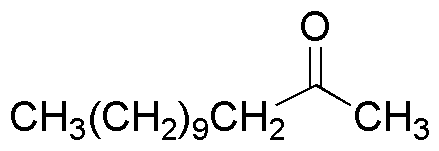2-Tridecanone is widely utilized in research focused on:
- Flavor and Fragrance Industry: This compound is used as a flavoring agent in food products and as a fragrance in cosmetics and personal care items, providing a pleasant scent and taste.
- Agricultural Applications: It serves as a natural insect repellent, helping to protect crops from pests without the use of harsh chemicals, making it an eco-friendly option for farmers.
- Analytical Chemistry: 2-Tridecanone is employed as a standard in gas chromatography, aiding researchers in accurately analyzing complex mixtures and ensuring precise results.
- Biological Research: It is used in studies investigating the behavior of certain organisms, particularly in understanding their responses to various chemical stimuli, which can lead to advancements in pest control strategies.
- Industrial Applications: This compound finds use in the production of surfactants and detergents, enhancing cleaning efficiency while being less harmful to the environment compared to traditional surfactants.
General Information
Properties
Safety and Regulations
Applications
2-Tridecanone is widely utilized in research focused on:
- Flavor and Fragrance Industry: This compound is used as a flavoring agent in food products and as a fragrance in cosmetics and personal care items, providing a pleasant scent and taste.
- Agricultural Applications: It serves as a natural insect repellent, helping to protect crops from pests without the use of harsh chemicals, making it an eco-friendly option for farmers.
- Analytical Chemistry: 2-Tridecanone is employed as a standard in gas chromatography, aiding researchers in accurately analyzing complex mixtures and ensuring precise results.
- Biological Research: It is used in studies investigating the behavior of certain organisms, particularly in understanding their responses to various chemical stimuli, which can lead to advancements in pest control strategies.
- Industrial Applications: This compound finds use in the production of surfactants and detergents, enhancing cleaning efficiency while being less harmful to the environment compared to traditional surfactants.
Documents
Safety Data Sheets (SDS)
The SDS provides comprehensive safety information on handling, storage, and disposal of the product.
Product Specification (PS)
The PS provides a comprehensive breakdown of the product’s properties, including chemical composition, physical state, purity, and storage requirements. It also details acceptable quality ranges and the product's intended applications.
Certificates of Analysis (COA)
Search for Certificates of Analysis (COA) by entering the products Lot Number. Lot and Batch Numbers can be found on a product’s label following the words ‘Lot’ or ‘Batch’.
*Catalog Number
*Lot Number
Certificates Of Origin (COO)
This COO confirms the country where the product was manufactured, and also details the materials and components used in it and whether it is derived from natural, synthetic, or other specific sources. This certificate may be required for customs, trade, and regulatory compliance.
*Catalog Number
*Lot Number
Safety Data Sheets (SDS)
The SDS provides comprehensive safety information on handling, storage, and disposal of the product.
DownloadProduct Specification (PS)
The PS provides a comprehensive breakdown of the product’s properties, including chemical composition, physical state, purity, and storage requirements. It also details acceptable quality ranges and the product's intended applications.
DownloadCertificates of Analysis (COA)
Search for Certificates of Analysis (COA) by entering the products Lot Number. Lot and Batch Numbers can be found on a product’s label following the words ‘Lot’ or ‘Batch’.
*Catalog Number
*Lot Number
Certificates Of Origin (COO)
This COO confirms the country where the product was manufactured, and also details the materials and components used in it and whether it is derived from natural, synthetic, or other specific sources. This certificate may be required for customs, trade, and regulatory compliance.

